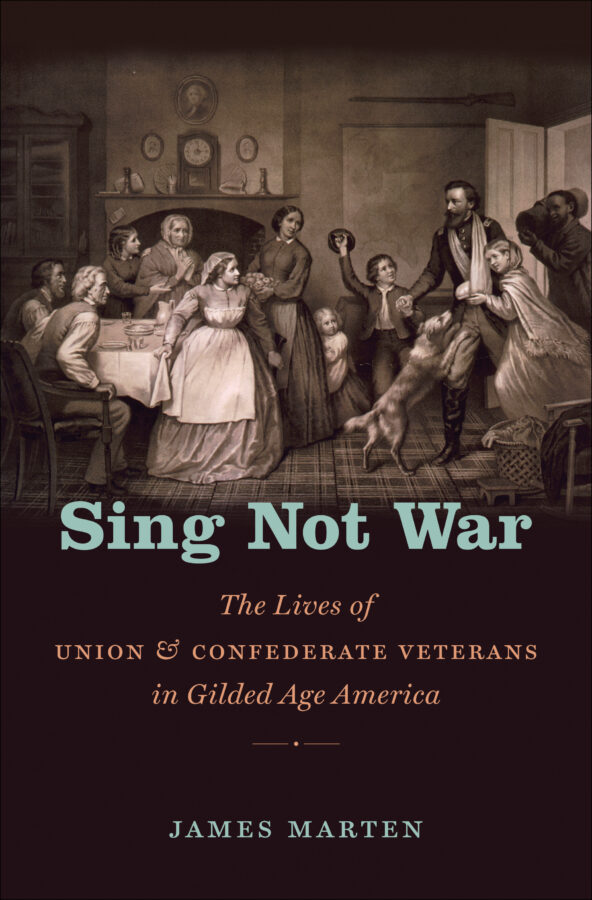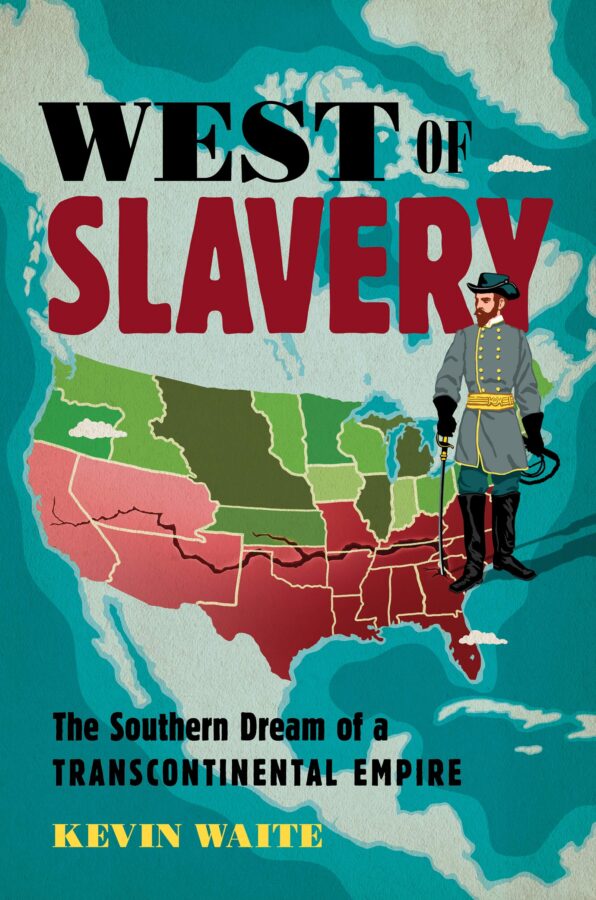Sing Not War: The Lives of Union and Confederate Veterans in Gilded Age America by James Marten. Chapel Hill: University of North Carolina Press, 2011. Cloth, ISBN: 0807834769. $39.95.
 Civil War veterans were everywhere in late-nineteenth century America. Virtually everyone had a relative or knew someone who once donned Union blue or Confederate gray. Union veterans paraded on Memorial Day, reminisced at local GAR posts, peddled regimental histories, and became the beneficiaries of federal pensions; their southern counterparts, revered as the manly defenders of the Lost Cause, assembled at UCV meetings, collected war relics, and were cheered by audiences at state fairs and bazaars. But as the historian James Marten makes clear in his elegantly written new book, Sing Not War: The Lives of Union & Confederate Veterans in Gilded Age America, the most conspicuous members of the “nineteenth century’s ‘Greatest Generation’” were also the most easily misunderstood (1).
Civil War veterans were everywhere in late-nineteenth century America. Virtually everyone had a relative or knew someone who once donned Union blue or Confederate gray. Union veterans paraded on Memorial Day, reminisced at local GAR posts, peddled regimental histories, and became the beneficiaries of federal pensions; their southern counterparts, revered as the manly defenders of the Lost Cause, assembled at UCV meetings, collected war relics, and were cheered by audiences at state fairs and bazaars. But as the historian James Marten makes clear in his elegantly written new book, Sing Not War: The Lives of Union & Confederate Veterans in Gilded Age America, the most conspicuous members of the “nineteenth century’s ‘Greatest Generation’” were also the most easily misunderstood (1).
While bookshelves groan under the weight of studies of common Civil War soldiers, historians have made precious little effort to follow either Johnny Reb or Billy Yank home from the war. Patrick Kelly and R.B. Rosenburg have explored life in Civil War veterans’ homes; Stuart McConnell, David Blight, and Gerald Linderman have explored the influence of veterans in memory battles and sectional reconciliation; Eric Dean has written a compelling study of the war’s psychological consequences; and Larry Logue wrote a brief survey of the ex-soldier in To Appomattox and Beyond. Marten’s book seeks to remedy this enormous historiographical void, providing readers with a synthetic social and cultural history of the lives of white veterans North and South. (Marten wisely sets aside African-American veterans, insisting that the racism they faced – a story that has been well told by Donald Shaffer – would overly complicate his story.) More so than any previous historian, Marten sheds light on several important questions: how did veterans live, and how were they perceived by society?
Borrowing his chapter titles from Walt Whitman’s poem “A Carol of Harvest, for 1867,” Marten begins the book with a narrative that stresses the “uneasy reentry” that some veterans made into civilian society (73). Civilians and some soldiers quite vocally feared the corrupting and demoralizing influence of the “wild life of the army” (51). Would men accustomed to the killing fields be able to return at once to peaceful pursuits? Would they be able to leave the war behind? Although many veterans tried to forget the war, this was obviously impossible for others. And though more than a few returned effortlessly to their homes and prewar occupations, others found themselves economically dislocated — victims of employers wary of the trustworthiness of discharged soldiers. Northern veterans in particular were typecast as moral profligates, drunken beasts, and remorseless beggars. More than anything, “contempt and contentiousness” characterized the demobilization of Civil War armies (73).
In stirring chapters on disabled and institutionalized veterans and the pension battles, Marten convincingly argues that these attitudes continued to shape the experiences of veterans in the late-nineteenth century; the chasm between those who served and those who did not, he insists, became wider amidst the social and cultural turmoil of Gilded Age America. Here, Marten makes a valuable distinction between the intra-sectional responses to Union and Confederate veterans. Determined to resist what they perceived as continued northern aggression during Reconstruction and beyond, Southerners cast Confederate veterans – an overwhelming majority of the military-age, white male population – as “proud, ragged, and honorable” men who fought for a worthy cause (20). In the North, however, where military service was not nearly as universal, those veterans who succumbed to intemperance, poverty, and vice could been interpreted as agents of their own demise, actively resisting the tide of prosperity, enterprise, and opportunity. Unfortunately, these differences (and a disparity in available source material) impel Marten to pay less attention to veterans in gray. As such, readers might profitably supplement Marten’s book with Jeffrey McClurken’s recent study of Virginia veterans and their families, Take Care of the Living.
Marten demonstrates that in the North, veterans’ homes and the chronic alcoholism their administrators attempted to combat helped to reinforce popular perceptions of veterans as feeble, incapable, irresponsible, and “less than truly men” (198). Veterans’ campaigns for preference and demands on the public purse also produced fierce struggles between ex-soldiers, who saw themselves as worthy heroes, and civilians, who saw pension supplicants as arrogant nuisances lacking self-respect. Marten adds to a vast literature on the Civil War pension battles by demonstrating how “Gilded Age anxieties about change, truth, and identity” coursed through these debates. In doing so, he reveals the social constructedness of the word “veteran” in the late-nineteenth century (201). Nonetheless, the book misses a brilliant opportunity to connect meaningfully to recent work on memory and remembrance. In Sing Not War, public perceptions of veterans’ lives are the driving force shaping civilian attitudes about ex-soldiers. But how did attitudes about the war itself color civilian perceptions of veterans? It is hardly a coincidence that veterans were cast aside as the spirit of reconciliation seized hold of American culture – that the image of the manly, unscathed veteran was devised at the very moment the war-weary northern home front sanitized its traumatic memories. Unable and unwilling to deal with unprecedented physical and emotional suffering, were Marten’s veterans cast aside by civilians in a conspiracy of silence akin to the one that for so long excised African-Americans from the mainstream Civil War narrative? Were these troubled veterans, often willing to forgive but never willing to forget, simply unconvincing characters for the nation’s ‘romance of reunion’? These questions eagerly await future historians.
The most fascinating chapter of Marten’s study assesses how veterans and civilians encountered one another in the marketplace. As both consumers and entrepreneurs, veterans participated in the commodification of both the war and their sacrifices – developing their former battlefields as tourist attractions, gathering for elaborate reunions, staging sham battles, amassing war relics, and peddling a panoply of newspapers, books, and sentimental kitsch. The “old soldier’s market” likely kept many late-nineteenth century businesses profitable, but these attempts to “commercialize” the war only generated further conflicts between soldiers and civilians and contributed to the idealized image of Civil War veterans (158).
Marten closes the book with a thought-provoking essay on the distinctive subculture shaped by Civil War veterans – the first noticeable, assertive cohort of war survivors in American history. Veterans routinely turned to each other in fraternal organizations and battlefield reunions, but a few thousand took separation to an extreme, forming peculiar “soldiers’ colonies” in the South and West to isolate themselves from non-veterans. Set apart as anachronisms in the South and castigated as wards of the state in the North, Marten concludes that veterans of both armies “lost control of their legacies” – unable to compete with the cultural power of ‘virtuous veterans’ and ‘strenuous men,’ two idealistic images that dominated the last decades of the nineteenth century (270).
Although he does more than any previous historian to upend the romanticized view of Civil War veterans, even Marten may somewhat underestimate the trials of homecoming and the complicated project of grappling with the war’s totality. He says little about disillusionment, what the victors thought they won (or didn’t win), and what the vanquished thought they lost (or didn’t lose). And Marten is rather noncommittal on the question of how representative his maladjusted veterans were, asserting that the experience of a few harbored the cultural power to shape perceptions of the whole, and writing that “most veterans managed peaceful and more or less satisfying transitions back to civilian life” (17). Sing Not War does so much to demonstrate the social constructedness of veteran stereotypes that it may undervalue the hard dose of truth that sanctioned them in the first place.
Marten’s book mines an impressive assortment of dime novels, veterans’ newspapers, and the testimony presented to investigators of soldiers’ homes in the late nineteenth century. The book, Marten writes, “draws heavily on sources that historians have not utilized” (18). Yet most curious and conspicuous is the absence of other types of oft-neglected sources: Marten does not cite a single veteran’s pension file, dismisses the utility of GAR post records (which, more than organizational minutiae, often reveal much about veterans’ lives), and fails to make use of several important manuscript collections pertaining to the lives of Union veterans in both New England and the West. These sources are indispensible to any historian who seeks to understand Civil War veterans as veterans. Indeed, Sing Not War may under-deliver on its promise to flesh out the interior lives of veterans. Marten explains the growing chasm between ex-soldiers and civilians, but ultimately tells us too little about how veterans experienced that alienation in everyday life. Asserting that a substantial minority of ex-soldiers found themselves “on the margins” of society and turned to each other is hardly enough. Finally, did unusual cohorts of veterans – ex-prisoners of war, former guerrillas, and cowards, to name only a few – experience greater alienation? If so, did this engender contests of suffering among veterans?
These questions aside, Sing Not War has given admirable shape and definition to an anemic subfield of Civil War history, and as such it is a welcome addition to the literature. Future studies of the war’s consequences must contend with the important questions that James Marten poses. Scholars of the war will no longer be permitted to end their histories at Appomattox, and historians of the late-nineteenth century will be obliged to gaze more intently at those “sad, unnatural shows of war” that crowded the streets of Gilded Age America (245).
